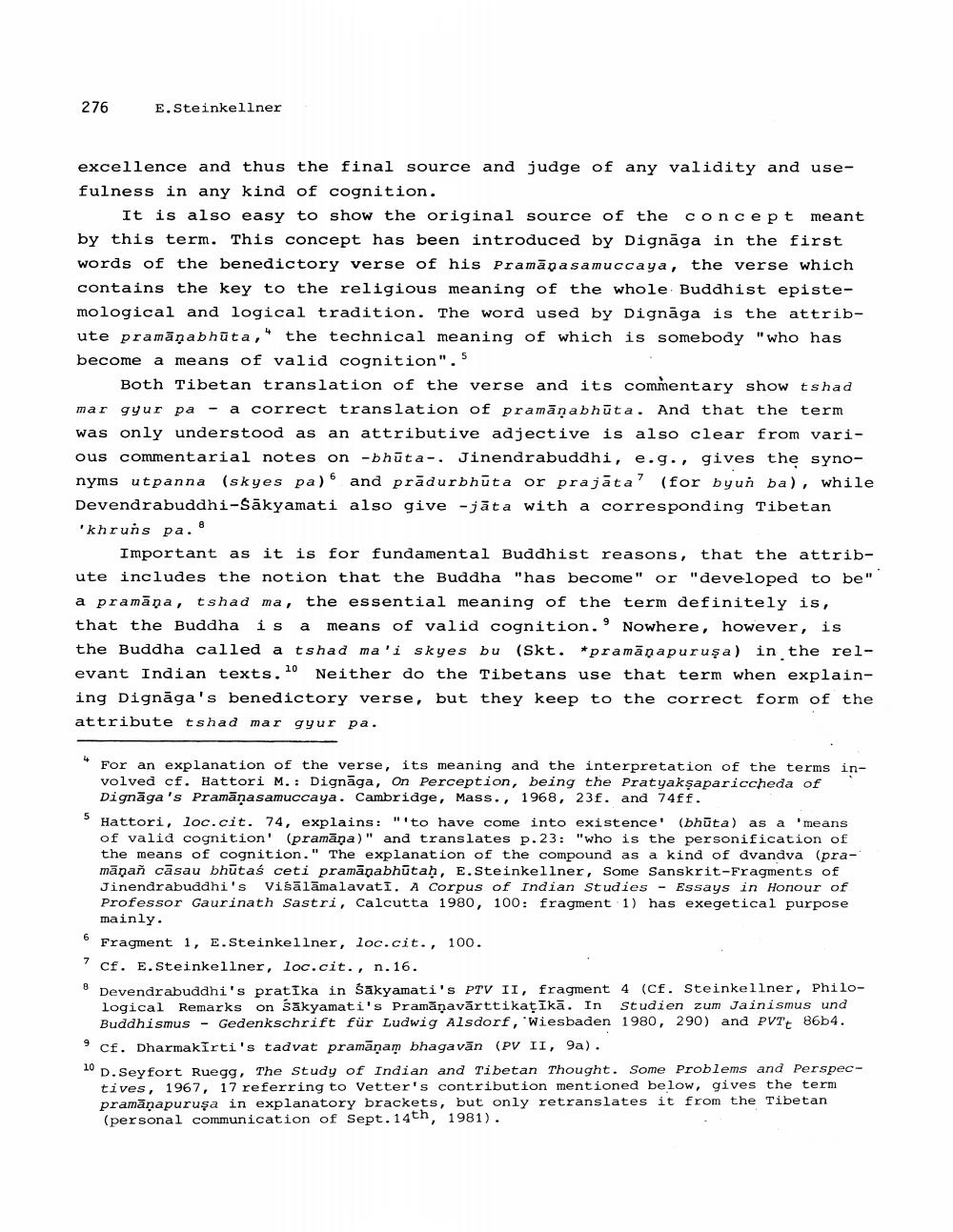Book Title: Meaning And Historical Significance Of Term Author(s): Ernst Steinkellner Publisher: Ernst Steinkellner View full book textPage 2
________________ 276 E.Steinkellner excellence and thus the final source and judge of any validity and usefulness in any kind of cognition. It is also easy to show the original source of the concept meant by this term. This concept has been introduced by Dignāga in the first words of the benedictory verse of his Pramāpasamuccaya, the verse which contains the key to the religious meaning of the whole Buddhist epistemological and logical tradition. The word used by Dignāga is the attribute pramāṇabhūta," the technical meaning of which is somebody "who has become a means of valid cognition".5 Both Tibetan translation of the verse and its commentary show tshad mar gyur pa - a correct translation of pramānabhūta. And that the term was only understood as an attributive adjective is also clear from various commentarial notes on -bhūta-. Jinendrabuddhi, e.g., gives the synonyms utpanna (skyes pa) and prādurbhūta or prajāta' (for byun ba), while Devendrabuddhi-Sākyamati also give -jāta with a corresponding Tibetan 'khruns pa. Important as it is for fundamental Buddhist reasons, that the attribute includes the notion that the Buddha "has become" or "developed to be" a pramāņa, tshad ma, the essential meaning of the term definitely is, that the Buddha is a means of valid cognition.o Nowhere, however, is the Buddha called a tshad ma'i skyes bu (Skt. *pramānapuruşa) in the relevant Indian texts. 10 Neither do the Tibetans use that term when explaining Dignāga's benedictory verse, but they keep to the correct form of the attribute tshad mar gyur pa. For an explanation of the verse, its meaning and the interpretation of the terms involved cf. Hattori M.: Dignāga, On Perception, being the Pratyakşapariccheda of Dignāga's Pramāṇasamuccaya. Cambridge, Mass., 1968, 23. and 74ff. Hattori, loc.cit. 74, explains: "'to have come into existence' (bhūta) as a 'means of valid cognition' (pramāna)" and translates p.23: "who is the personification of the means of cognition." The explanation of the compound as a kind of dvandva (pramāņañ cāsau bhūtaś ceti pramānabhūtah, E.Steinkellner, Some Sanskrit-Fragments of Jinendrabuddhi's Visālāmalavati. A Corpus of Indian Studies - Essays in Honour of Professor Gaurinath Sastri, Calcutta 1980, 100: fragment 1) has exegetical purpose mainly. 6 Fragment 1, E.Steinkellner, loc.cit., 100. 7 cf. E.Steinkellner, loc.cit., n.16. Devendrabuddhi's pratîka in Sakyamati's PTV II, fragment 4 (Cf. Steinkellner, Philological Remarks on Sakyamati's Pramāņavārttikatikā. In Studien zum Jainismus und Buddhismus - Gedenkschrift für Ludwig Alsdorf, Wiesbaden 1980, 290) and PVTt 86b4. 9 Cf. Dharmakirti's tadvat pramāņam bhagavān (PV II, 9a). 10 D. Seyfort Ruegg, The Study of Indian and Tibetan Thought. Some Problems and Perspec tives, 1967, 17 referring to Vetter's contribution mentioned below, gives the term pramānapuruşa in explanatory brackets, but only retranslates it from the Tibetan (personal communication of Sept. 14th, 1981).Page Navigation
1 2 3 4 5 6 7 8 9 10 11
